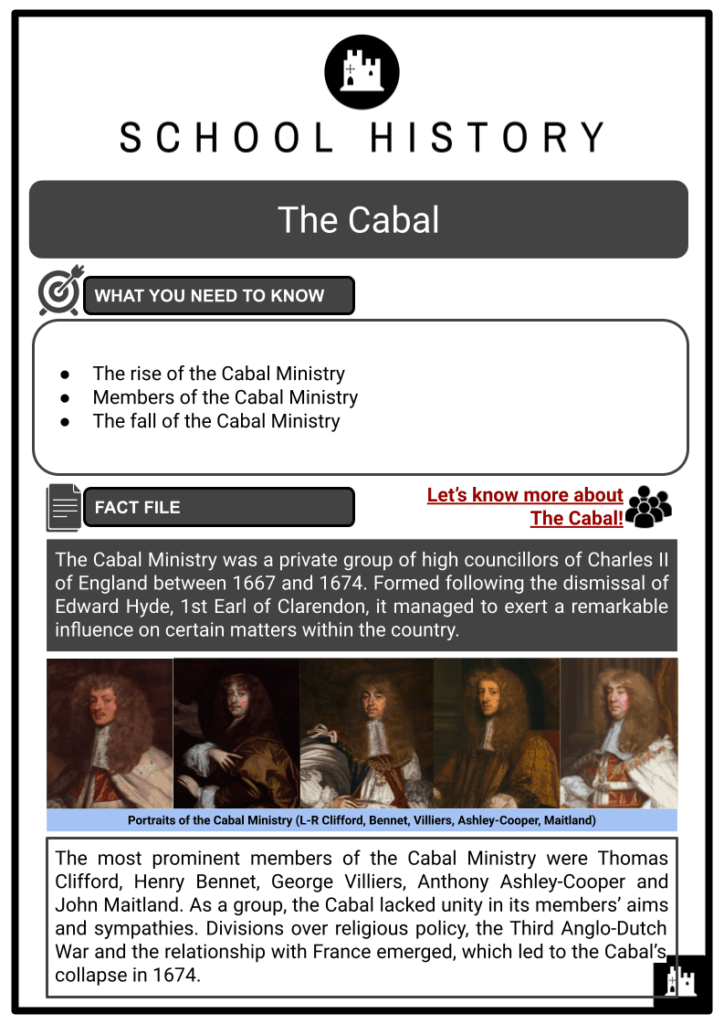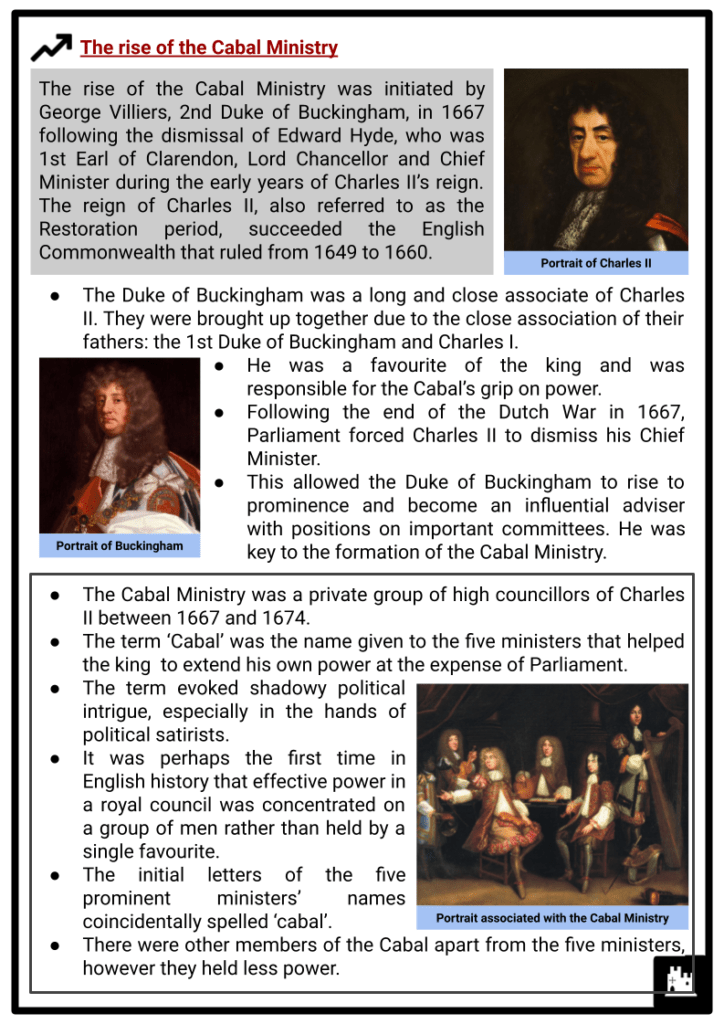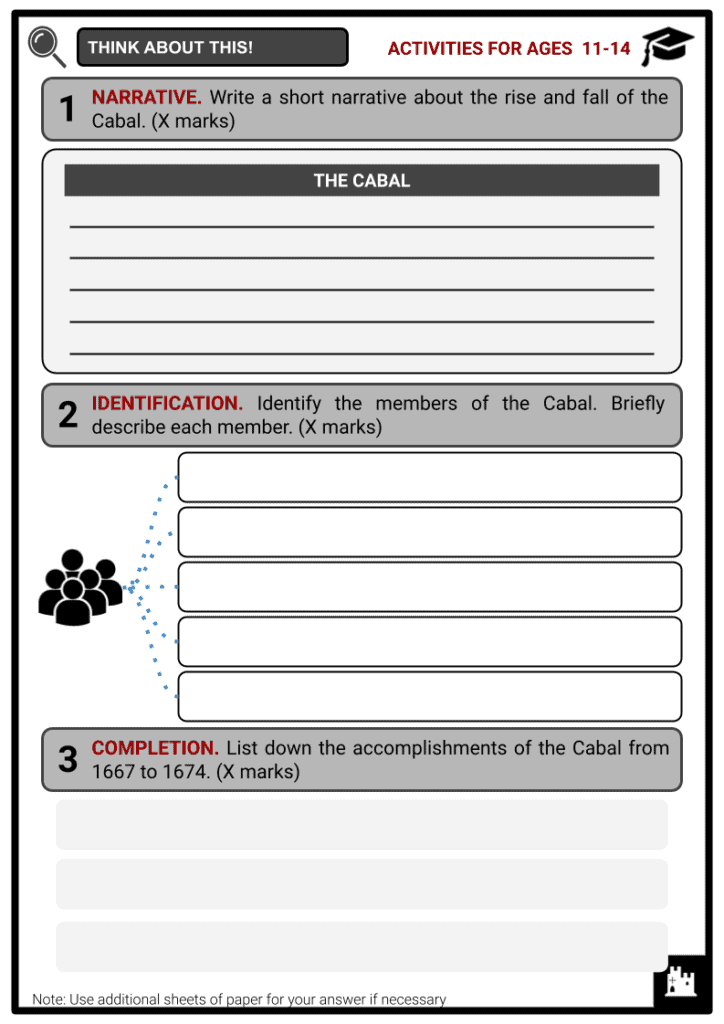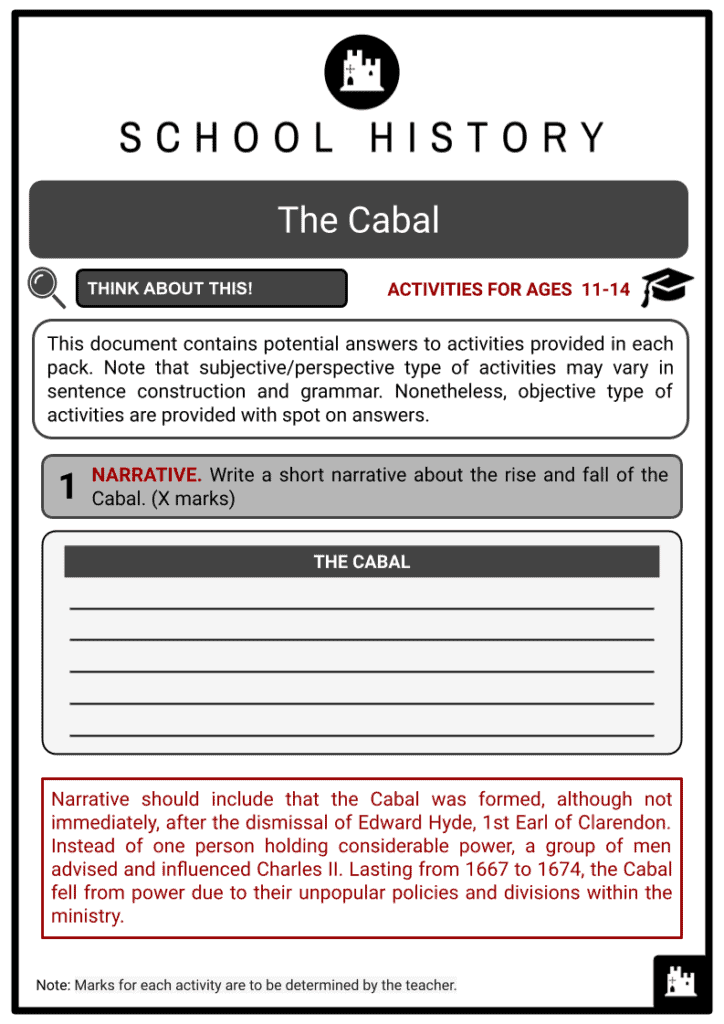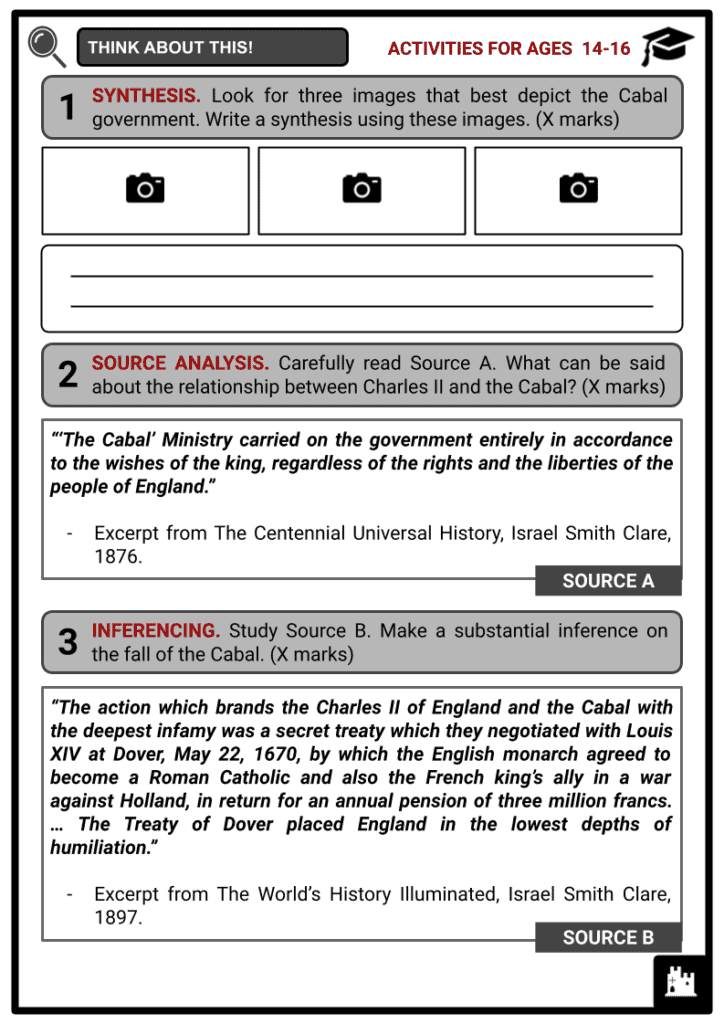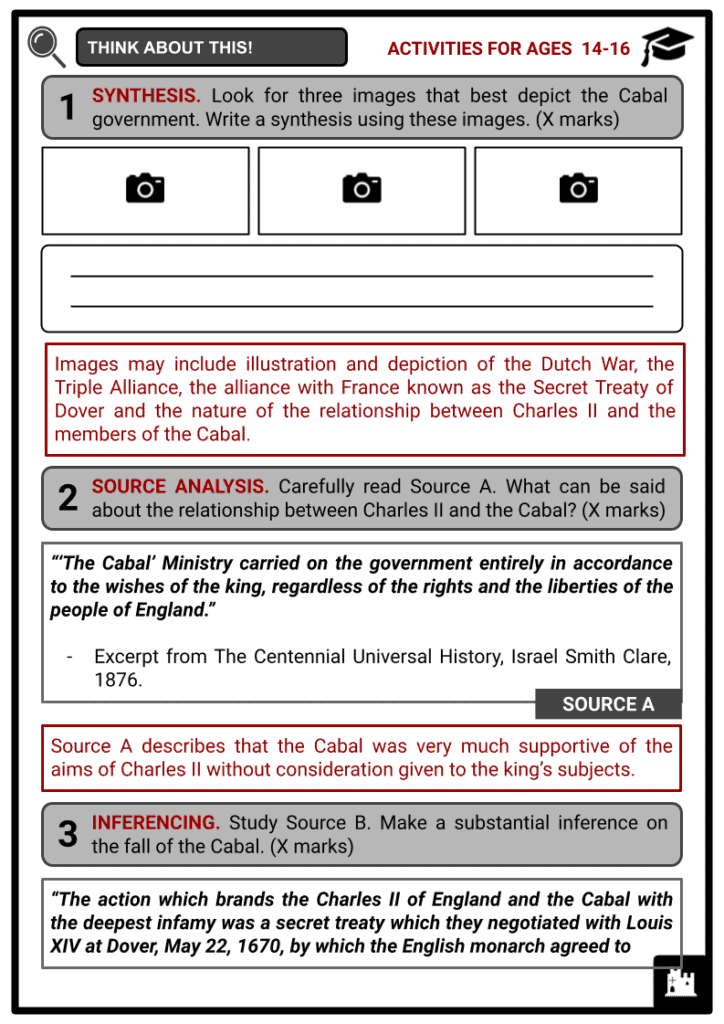Download The Cabal Worksheets
Do you want to save dozens of hours in time? Get your evenings and weekends back? Be able to teach The Cabal to your students?
Our worksheet bundle includes a fact file and printable worksheets and student activities. Perfect for both the classroom and homeschooling!
Table of Contents
Add a header to begin generating the table of contents
Summary
- The rise of the Cabal Ministry
- Members of the Cabal Ministry
- The fall of the Cabal Ministry
Key Facts And Information
Let’s find out more about The Cabal!
- The Cabal Ministry was a private group of high councilors of Charles II of England between 1667 and 1674. Formed following the dismissal of Edward Hyde, 1st Earl of Clarendon, it managed to exert a remarkable influence on certain matters within the country.

- The most prominent members of the Cabal Ministry were Thomas Clifford, Henry Bennet, George Villiers, Anthony Ashley-Cooper and John Maitland. As a group, the Cabal lacked unity in its members’ aims and sympathies. Divisions over religious policy, the Third Anglo-Dutch War and the relationship with France emerged, which led to the Cabal’s collapse in 1674.
The rise of the Cabal Ministry
- The rise of the Cabal Ministry was initiated by George Villiers, 2nd Duke of Buckingham, in 1667 following the dismissal of Edward Hyde, who was 1st Earl of Clarendon, Lord Chancellor and Chief Minister during the early years of Charles II’s reign. The reign of Charles II, also referred to as the Restoration period, succeeded the English Commonwealth that ruled from 1649 to 1660.
- The Duke of Buckingham was a long and close associate of Charles II. They were brought up together due to the close association of their fathers: the 1st Duke of Buckingham and Charles I.
- He was a favourite of the king and was responsible for the Cabal’s grip on power.
- Following the end of the Dutch War in 1667, Parliament forced Charles II to dismiss his Chief Minister.
- This allowed the Duke of Buckingham to rise to prominence and become an influential adviser with positions on important committees. He was key to the formation of the Cabal Ministry.
- The Cabal Ministry was a private group of high councillors of Charles II between 1667 and 1674.
- The term ‘Cabal’ was the name given to the five ministers that helped the king to extend his own power at the expense of Parliament.
- The term evoked shadowy political intrigue, especially in the hands of political satirists.
- It was perhaps the first time in English history that effective power in a royal council was concentrated on a group of men rather than held by a single favourite.
- The initial letters of the five prominent ministers’ names coincidentally spelled ‘cabal’.
- There were other members of the Cabal apart from the five ministers, however they held less power.
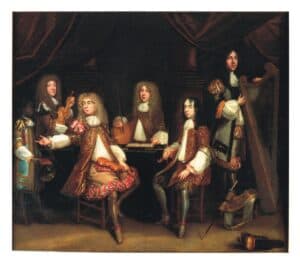
Members of the Cabal Ministry
- All Cabal members had excellent knowledge in the fields of politics and diplomacy and were also able to spread their influence by being brilliant speakers in Parliament. With the exception of the Duke of Buckingham, all the cabinet ministers of Charles II acquired their titles in the 1770s, which were mostly passed to their descendants.
Who were the Cabal?
Thomas Clifford
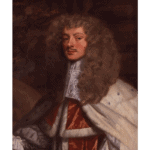
- Thomas Clifford attended Exeter College, Oxford and graduated in 1650. He became a barrister of the Middle Temple and a member of Parliament from 1660.
- Between 1666 and 1668 he was appointed controller of the household, a privy councillor, a commissioner for the treasury, and treasurer of the household.
- As one of the Cabal, Clifford cooperated eagerly with the king in breaking through the Triple Alliance with the Dutch Republic and Sweden and in concluding an understanding with France.
- He became 1st Baron Clifford of Chudleigh and was made Lord Treasurer in 1672.
- Soon after, however, the Test Act of 1673 excluded all Catholics from holding public office and Clifford was stripped of his duties. His death a few months later may have been a suicide.
Henry Bennet, Count of Arlington
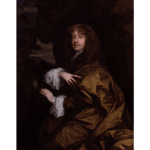
- Henry Bennet attended Westminster School and earned the reputation of a great scholar and poet.
- He then took up arms in favour of Charles I and participated in a clash in the city of Andover in 1644, where he got his nose injury.
- During the Commonwealth Republican government, he joined the royal family exiled in France in 1650.
- In 1654 he became the official secretary of the Prince of Wales’ brother, James, Duke of York.
- In 1657 Bennet was sent to the court of Madrid with King of Spain Philip IV, as an ambassador to seek economic and military aid.
- With the restoration of Charles II in 1661, he was called to London and was entrusted with important tasks that led him to become one of the most influential men in the kingdom.
- From 1661 to 1665 he was the secretary of state and, in 1667, in effect the chief minister of state.
- He was raised to the peerage in 1663 and given an earldom in 1672.
- As a leading member of Charles II’s Cabal, he negotiated the Protestant Triple Alliance – of England, the Dutch Republic and Sweden – and was involved in securing the pro-French and pro-Catholic policies embodied in the Secret Anglo-French Treaty of Dover.
- In 1674 he resigned the secretaryship of state for the safer position of Lord Chamberlain. He held that office until his death early in the reign of James II.
George Villiers, 2nd Duke of Buckingham
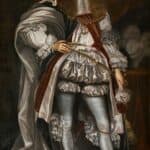
- Following the assassination of his father in 1628, George Villiers was brought up in Charles I’s family, where he became a constant companion to Prince Charles.
- When the prince was proclaimed king in 1651 after the execution of Charles I, he joined the king and fought valiantly for his cause. His courage ensured him the king’s favour during the Restoration.
- He went into exile during the Commonwealth government but returned illegally to England in 1657, which led to his imprisonment until 1659.
- Following the restoration of Charles II, he became a gentleman of the bedchamber and a privy councillor.
- As part of the Cabal, Villiers initially had great influence with the king but lost a power struggle with Bennet.
- Whilst he was in support of the alliance with France, he never knew the intention of Bennet and the king to restore Catholicism to England.
- In 1674 he was dismissed from his posts for alleged Catholic sympathies.
- He retired from public life after the accession to the throne of James II of England and moved to Yorkshire in 1681.
Anthony Ashley-Cooper
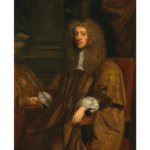
- Anthony Ashley-Cooper held an important political role during the Commonwealth and Restoration.
- He was one of the founders of the Whig Party and a patron of philosopher John Locke.
- He was a member of the Council of State but resigned in 1655 in protest against the regime’s dictatorial tendencies.
- During the Restoration, he was Chancellor of the Exchequer in the Clarendon government, then Lord Chancellor in the Cabal Ministry.
- He was created Earl of Shaftesbury in 1672.
- He fell out of favour in 1673 and was imprisoned in the Tower of London from 1675 to 1678.
- Due to his support for the Duke of Monmouth, he was accused of high treason and chose to go into exile in 1681.
John Maitland, Duke of Lauderdale
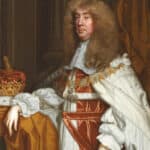
- John Maitland became a member of the Privy Council of England and the Privy Council of Scotland in 1644.
- He set about various undertakings for the restoration of Charles I.
- In 1648 he returned to Scotland during the Second English Civil War and joined Hamilton’s party, which supported the English royalists.
- Just before the restoration, he joined Charles II in Breda in May 1660 and, despite the opposition, he was appointed Secretary of State for Scotland.
- Although he was one of the Cabal, he held relatively little power and was not invited to take part in the first Secret Treaty of Dover due to his Presbyterian beliefs.
- In 1672 he became Duke of Lauderdale and subsequently Knight of the Garter. He was also appointed Lord President of the Privy Council of Scotland in 1672, a position he held until 1681.
- In 1680, his failing health forced him to resign from the Privy Council of England.
The fall of the Cabal Ministry
- The Cabal Ministry led an unpopular policy of royal absolutism and consistently attacked the House of Commons. Unfulfilled personal ambitions and hostility amongst ministers and much disagreement ruled in Parliament and between political factions.
- For example, members of the Cabal were not able to agree on issues regarding faith: whilst Clifford embraced Catholicism, the Duke of Buckingham was vehemently opposed to it.
- Similarly, there was disagreement over the foundations of the political establishment: Ashley-Cooper, with his former involvement in the Republican government, promoted the parliamentary system, whereas Maitland was an uncompromising supporter of royal absolutism.
- Personal disputes between Bennet and Maitland also existed.
- The government also suffered from the disclosure of the Secret Treaty of Dover, according to which Charles II would secretly receive a yearly pension of £230,000. As a consequence, Bennet had to justify the treaty in front of Parliament.
- In addition, the Cabal was unpopular with the public, who saw them as privileged and self-serving.
- The collapse of the Cabal Ministry followed the adoption of the Test Act, which eliminated Catholic influence on the government. The Cabal ended in September 1674 when Bennet was recalled from the position of Secretary of State.
Image Sources
- https://www.npg.org.uk/collections/search/portrait/mw01340/Thomas-Clifford-1st-Baron-Clifford-of-Chudleigh
- https://www.npg.org.uk/collections/search/portrait/mw00179/Henry-Bennet-1st-Earl-of-Arlington
- https://artuk.org/discover/artworks/george-villiers-16281687-2nd-duke-of-buckingham-governor-of-the-charterhouse-from-1670-304127
- https://www.npg.org.uk/collections/search/portrait/mw05714/Anthony-Ashley-Cooper-1st-Earl-of-Shaftesbury?LinkID=mp04048&role=sit&rNo=0
- http://www.nationaltrustcollections.org.uk/object/1139952
- http://www.polyolbion.org.uk/Hanwell/Thomas/Cabal.jpg

